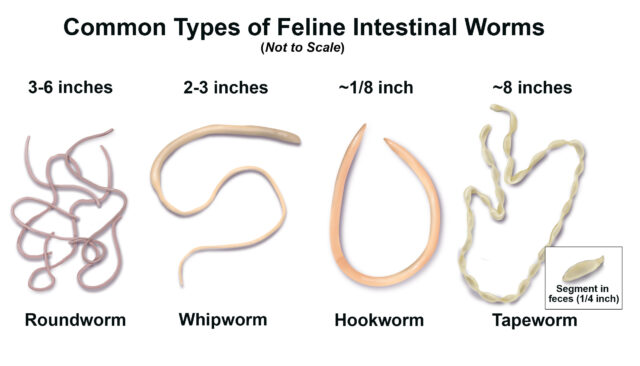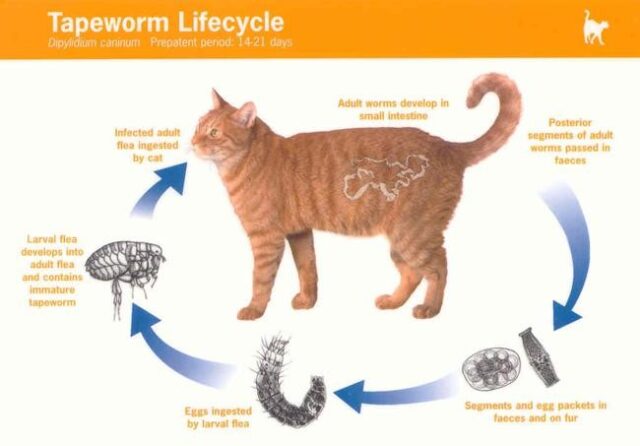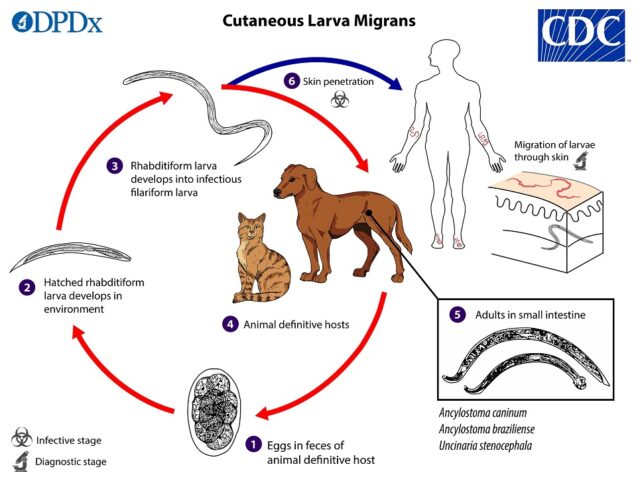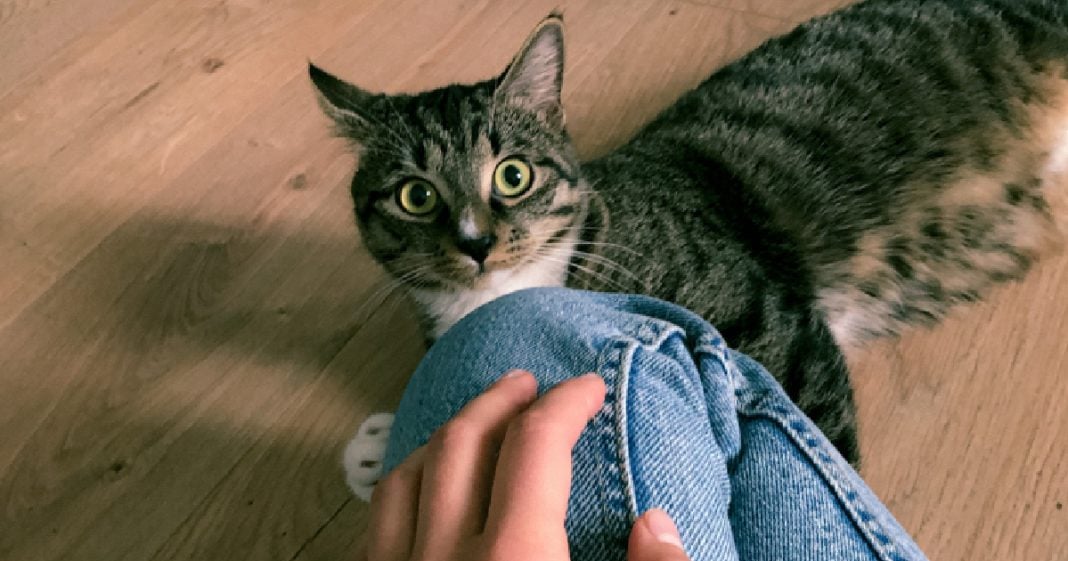Nobody wants to think about worms in cats, but as devoted feline fanatics, it’s a creepy-crawly topic that must be broached. It might gross you out to think about your furry darling being infected by nasty parasites, but it’s a fact that can’t be ignored. Your cat’s health is more important than squeamish feelings.
Your cat certainly doesn’t want to think about them either, but when they’re writhing around inside a feline body, then kitty dear doesn’t have a choice! And cats are meticulous creatures with a deep need to be clean and tidy. Imagine what they’re feeling about an infestation…
Though small, these parasites loom large in the feline world, so let’s cast our disgusted squirms aside and get down to the business of worms in cats.

Types of Worms in Cats
Felines are natural hunters who enjoy eating the spoils of their predatory victory, but this can sometimes cause worms. Gross as it seems, parasitic worms are a natural part of dealing with the little predators that are our cats. The most common worms cat parents will encounter are intestinal worms, with roundworms and tapeworms being the most prevalent.
Watch out for these GI worms in cats:
- Roundworms
- Tapeworms
- Hookworms
- Whipworms
- Stomach worms

There are also worms that affect other systems of the feline body, such as:
- Heartworms
- Eyeworms
- Lungworms
- Bladder worms
- Liver flukes
And while worms in cats aren’t an extreme emergency for an otherwise healthy cat, in kittens, parasitic infections are cause for alarm. Those tiny bodies can be overtaken by worms and decline rapidly.

Gastrointestinal Worms
Roundworms
A common problem among felines, the Cornell Feline Health Center reports a quarter to three-quarters of cats will experience roundworms, and that average is even higher among kittens. Looking like yucky, off-white spaghetti noodles, roundworms make themselves at home in a cat’s intestines. They survive on the food a cat eats, reaching up to 5 inches long as an adult creepy-crawly.
Roundworm Symptoms
Symptoms of roundworms in cats may be minimal in adults and more pronounced in kittens. PetMD advises cat parents to be on the lookout for these symptoms:
- Abdominal pain
- Swelling in the stomach, kittens may have a pot-bellied appearance
- Vomiting
- Diarrhea
- Lack of appetite
- Fatigue and weakness
- Coughing, a result of roundworm larvae traveling into feline lungs
The most common of the intestinal worms, roundworm infections are caused by Toxascaris leonina and Toxocara cati, and can be picked up from infested dirt or infected prey. Cats ingest the roundworm eggs and the cycle begins. But it’s kind of a wonder roundworms infect so many cats with their complicated life cycle. Ready for some worm weirdness? Check this out.
The first and most typical route of infection for kittens is what Dr. Ernest Ward terms “trans-mammary or milk-borne infection.” While nursing, kittens can ingest roundworm larvae as they pass through the mammary glands of a nursing mom. Kittens then swallow the eggs, which hatch in those little tummies and spread. Not so strange, but just wait, it’s what happens after eggs hatch in the stomach.

As mentioned, adult cats can pick up roundworms from infected soil and, by simply licking their paws, ingest the eggs. Eating infected prey can also do the nasty trick too. However the eggs get to a cat’s stomach, this is where the cycle begins, hatching along the gastrointestinal line. After the hatch, the larvae worm their way into the lungs, liver, and other tissues. Once the larvae near maturity, they find their way back to the intestines, where they mature and hang out, growing and releasing eggs. The eggs are then excreted and a new cycle is begun.
Dr. Ward also explains, “During migration, some roundworm larvae may encyst (the larvae become enclosed in a cyst) in a dormant state in the host’s body. In female cats, the larvae can come out of the cyst during pregnancy. These larvae can then be passed to the kittens across the placenta during pregnancy, or through the milk after birth.”
If your cat has roundworms, you may see worms in their litter pan or in vomit. Otherwise, you may never see a symptom of worms in cats. Roundworms are typically found with a float test and microscopic investigation through a routine fecal check at your vet’s office. A cat parent may not even realize their cat has roundworms until a vet exam discovers them, but once diagnosed, go ahead and treat your cat. While roundworms might not bring about any problems for a healthy adult cat, kittens and senior cats with health issues are at risk for complications surrounding roundworm infections.

Tapeworms
One of the most common worms in cats, this flatworm actually resembles the common worm image people conjure up when thinking of intestinal parasites. Attaching to the lining of the small intestine with a nasty hook mouth, tapeworms are white or cream in color and grow up to 11 inches long.
The Cornell Feline Health Center explains, “Their small head is connected to a series of segments filled with eggs” and these segments then break off when mature, passing through the intestines to land in the litter pan in the end.
Tapeworm Symptoms
Parents usually realize a cat has tapeworms when they see segments, known as proglottids, in their cat’s poop or even caught in the fur around the anus. And yes, when fresh, those pieces contract and squirm. Dry pieces look like sesame seeds or small grains of rice and break open to release the eggs. While this may be the only indication you notice, your cat might exhibit these general symptoms if the infestation has been going on for a while:
- Vomiting
- Weight loss (tapeworms absorb nutrients from the cat’s diet)
- Butt dragging

Cats pick up the most common types of tapeworms by ingesting fleas or wildlife which has consumed tapeworm eggs. Dipylidium caninum, also known as the ‘flea tapeworm’ plagues cats after they’ve eaten an infected flea. The Taenia taeniaeformis variety comes from eating infected rodents.
The best way to prevent tapeworms in cats is by treating felines with anti-flea medication and controlling rodent populations. If your cat is a natural ratter, keep a keen eye out for parasitic infections.
Hookworms
Like tapeworms and roundworms, hookworms hang out in the digestive tract. These little creeps hook into the lining of your cat’s intestines and feed off their blood. Vampires they may be, but not the kind you want knocking at your window in the dark of night. As they feed off blood, hookworms can damage a cat’s health, causing weight loss and anemia. For kittens, these problems can be life-threatening.
Hookworm Symptoms
With similar life cycles and transmission routes as roundworms and tapeworms, hookworms also present with many of the same symptoms, but include some frightening ones as well. Look for these symptoms of hookworms in cats:
- Constipation
- Diarrhea
- Black, tarry stool resulting from digesting blood
- Dull fur
- Weight loss
- Itchy, irritated skin or rashes
- Paw pad sores, generally seen in heavy infestation
Hookworms can cause severe illness if left untreated. Call the vet if you suspect hookworms have taken hold of your kitty.

Whipworms
Another intestinal worm, the whipworm is the smallest of the bunch and lives in the large intestines of its host. These parasites can infect cats, but as veterinarian Dr. Wendy Brooks explains, “Cats are clean animals and fastidious around feces, and they rarely get infected. When they do, worm numbers are so small that symptoms hardly ever occur.”
Whipworms can be treated with dewormers, and many medications formulated for heartworms have ingredients that help with whipworm prevention.
Stomach Worms
Found more in outdoor and feral cats, but still uncommon in the U.S., stomach worms are exactly what you’re picturing. A small, but gross worm that lives in the stomach of its host, hanging on to the lining. The Companion Animal Parasite Council reports symptoms of stomach worms in cats as “chronic vomiting, increased gastric mucous production, weight loss, and anorexia.”
There are two types of stomach worms that affect cats. The Physaloptera spp. variety comes from eating an infected host. The Ollulanus tricuspis type comes from eating the infected vomit of another cat or other animal. Appetizing…

How To Treat Intestinal Worms in Cats
Worms in cats are treated with anthelmintic medications via injections or oral tablets. Commonly known as dewormers, these worm treatments typically have to be administered in more than one dose. Larva and eggs can evade medication but once they’ve reached maturity, treatment will obliterate the gross invaders.
To get rid of worms in cats, make an appointment with the vet. Doctors have access to the best information and the right medications for certain types of parasites. They also know the right prescribing schedules to best catch worms in cats as they mature enough to be destroyed by medications.
There are cat deworming products for purchase over-the-counter, but before giving your cat any medications, talk to the vet. The same goes for any homeopathic recipes that promise to get rid of worms in cats naturally.
How to Prevent Intestinal Worms in Cats
With a few simple steps, you can help your cat steer clear of wormy invaders:
- Be sure felines visit the vet annually for all important screenings, including fecal sampling, which looks for signs of worms in cats.
- Use flea and tick preventive medicines. If possible, choose products that also provide protection against intestinal worms.
- Keep the litter box clean and scooped. Remove the poops daily and clean the litter pan with disinfectant soap on a regular basis.
- Sweep and vacuum regularly, as well as keeping your cat’s bedding fresh and clean.
- Feed cats fully cooked meat or, if on a raw diet, follow all safe-handling procedures.
- For kittens, follow recommended protocols for deworming.
- Nursing mothers can also be dewormed to prevent the passing of parasites to kittens.
- Keep cats indoors as much as they will allow.
Potential Risk for Human Infection
Also, be aware that roundworms, tapeworms, and hookworms all have the potential to infect humans. Good hygiene in the house and the litter pan will help to eliminate the risk of cat-to-human transmission of icky parasites. Treat cats for worms to minimize transmission risks.
Other Types of Worms in Cats
Most often, cats are infected by intestinal worms, but there are parasitic worms that invade other body parts. Fortunately, most of these are rarely seen in felines.
Heartworms
Spread through the bite of infected mosquitoes, heartworms invade the heart, lungs, and blood vessels of a host and have the potential for growing up to a foot long. They pose a major risk to infected animals, causing damage to the organs involved and even death. Good news for felines, though, cats are not a usual host for heartworms, which helps keep them from surviving to the adult stage, according to The American Heartworm Society.
“While this means heartworm disease often goes undiagnosed in cats, it’s important to understand that even immature worms cause real damage in the form of a condition known as heartworm associated respiratory disease (HARD).”
There are currently no approved medications to treat heartworms in cats, so prevention is key.

Eyeworms
A problem for felines on the U.S. west coast and Asian continent, cats suffer with eyeworms when infected flies deposit eggs around the eyes while making a meal of eye secretions. A quarter to three-quarters of an inch long, the worms can be seen wiggling in the eyes! Can you say nightmare? The Merck Manual suggests physical removal in conjunction with prescribed medications.
Lungworms
The most common form of the lungworm, Aelurostrongylus abstrusus, infects cats worldwide due to contact with small rodents, lizards, frogs, and birds. These coiled worms with whipping tails bury themselves deep into lung tissues where they lay eggs to continue the infestation cycle. Symptoms of lungworms in cats can resemble those of respiratory illnesses. Most cats will be just fine after deworming treatment, but take special care with kittens, felines with weakened immune systems, and senior cats. They may require extra medications to help heal their lungs.

Bladder Worms
A rare occurrence in cats, bladder worms come from eating infected earthworms and can be treated with dewormers. Also known as hairworms, they may not cause any symptoms in a cat, but Dr. Catherine Barnette, DVM, says, “Infection may lead to blood in the urine, urinary accidents, and straining to urinate.”
Liver Flukes
PetMD reports frogs, snails, and lizards are often the source of liver fluke infections in cats living in “Florida, Hawaii, and other tropical and subtropical areas.” While many cats don’t exhibit symptoms, some felines fall quite ill, displaying:
- Loss of appetite
- Weight loss
- Diarrhea
- Jaundice
- Enlarged liver
- Pot belly appearance
- Fever
Treatment will depend on the severity of the infection and cats that suffer from heavy symptoms will need more advanced care.

Alright, are your insides crawling yet? Let’s hope not! And let’s also hope your cat isn’t squirmy on the inside either!





